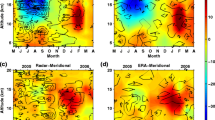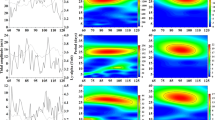Abstract
An analysis of time variations in the earth’s length of day (LOD) for 25 years (1973–1998) versus atmospheric circulation changes and lunar phase is presented. It is found that, on the average, there is a 27.3-day and 13.6-day period oscillation in global zonal wind speed, atmospheric geopotential height, and LOD following alternating changes in lunar phase. Every 5–9 days (6.8 days on average), the fields of global atmospheric zonal wind and geopotential height and LOD undergo a sudden change in relation to a change in lunar declination. The observed atmospheric oscillation with this time period may be viewed as a type of atmospheric tide.
Ten atmospheric tidal cases have been analyzed by comparing changes in LOD, global zonal wind speed and atmospheric geopotential height versus change in lunar declination. Taken together these cases reveal prominent 27.3-day and 13.6-day tides. The lunar forcing on the earth’s atmosphere is great and obvious changes occur in global fields of zonal wind speed and atmospheric geopotential height over the equatorial and low latitude areas.
The driving force for the 27.3-day and 13.6-day atmospheric tides is the periodic change in lunar forcing during the moon’s revolution around the earth. When the moon is located on the celestial equator the lunar declination equals zero and the lunar tidal forcing on the atmosphere reaches its maximum, at this time the global zonal wind speed increases and the earth’s rotation rate decreases and LOD increases. Conversely, when the moon reaches its most northern or southern positions the lunar declination is maximized, lunar tidal forcing decreases, global zonal wind speed decreases, earth’s rotation rate increases and LOD decreases.
27.3-day and 13.6-day period atmospheric tides deserve deeper study. Lunar tidal forcing should be considered in models of atmospheric circulation and in short and medium range weather forecasting.
Similar content being viewed by others
References
Eubanks T M, Steppe J A, Dickey J O, et al. A spectral analysis of the earth’s angular momentum budget. J Geophys Res, 1985, 90: 5385–5404
Dickey J O, Marcus S L, Steppe J A, et al. The earth’s angular momentum budget on subseasonal time scales. Science, 1992, 255: 321–324
Dickey J O, Eubanks T M, Steppe J A. High accuracy Earth rotation and atmospheric angular momentum. In: Cazenave A ed. Earth Rotation: Solved and Unsolved Problems. Dordrecht: D Reidel Publishing Company, 1986. 137–162
Lambeck K. The Earth’s Variable Rotation: Geophysical Causes and Consequences. Cambridge: Cambridge University Press, 1980
Rosen R D, Salstein D A. Variations in atmospheric angular momentum on global and regional scales and the length of day. J Geophys Res, 1983, 88: 5451–5470
Zheng D, Luo S, Song G. Interannual change in earth’s rotation, Elnino event and atmospheric angular momentum. Sci China Ser B (in Chinese), 1989, 28(3): 323–337
Liao D C, Greiner-Mai H. A new ΔLOD series in monthly intervals (1892.0–1997.0) and its comparison with other geophysical results. J Geodesy, 1999, 73: 466–477
Johnson T J, Wilson C R, Chao B F. Oceanic angular momentum variability estimated from the parallel ocean climate model, 1988–1999. J Geophys Res, 1999, 104(25): 183–195
Madden R A, Julian P R. Detection of a 40–50 day oscillation in the zonal wind in the tropical Pacific. J Atmos Sci, 1971, 28: 702–708
Madden R A. Relationships between changes in the length of day and the 40 to 50-day oscillation in the tropics. J Geophys Res, 1987, 92: 8391–8399
Li C Y, Wu P L, Zhang Q. Some characteristics of 30–50-day oscillation in northern hemisphere atmospheric circulation. Sci China Ser B (in Chinese), 1990, 20(7): 764–774
Jones C, Waliser D E, Lau K M, et al. The Madden-Julian Oscillation and its impact on Northern Hemisphere weather predictability. Mon Wea Rev, 2004, 132: 1462–1471
Waliser D E, Murtugudde R, Lucas L E. Indo-Pacific Ocean Response to atmospheric intraseasonal variability. Part 2: Boreal summer and the intraseasonal oscillation. J Geophys Res, 2004, 109: C03030, 1–26
Wu M L, Schubert C S, Kang I S, et al. Forced and free intra-seasonal variability over the South Asian monsoon region simulated by 10 AGCMs. J Climate, 2002, 15: 2862–2880
Yoder C F, Williams J G, Parke M E. Tidal variations of earth rotation. J Geophys Res, 1981, 86(B2): 881–891
Li G. 27.3-day and 13.6-day atmospheric tide and lunar forcing on atmospheric circulation. Adv Atmos Sci, 2005, 22: 359–374
Kistler R, Kalnay E, Collins W, et al. The NCEP-NCAR 50-year reanalysis: monthly means CD-ROM and documentation. Bull Amer Meteor Soc, 2001, 82: 247–267
Allen C W. Allen’s Astrophysical Quantities. New York: AIP Springer-Verlag, 2000
Chapman S, Linzen, R S. Atmospheric Tides Thermal and Gravitational. Dordrecht: D Reidel Publishing Company, 1970
Kähler M. In: Nierenberg W A. ed. Encyclopedia of Earth System Science. San Diego California: Academic Press Inc, 1992. 273–283
Lindzen R S. Dynamics in Atmospheric Physics. Cambridge: Cambridge University Press, 2005
Author information
Authors and Affiliations
Corresponding author
Additional information
Supported by the National Natural Science Foundation of China (Grant No. 40675031)
Rights and permissions
About this article
Cite this article
Li, G., Zong, H. 27.3-day and 13.6-day atmospheric tide. SCI CHINA SER D 50, 1380–1395 (2007). https://doi.org/10.1007/s11430-007-0069-x
Received:
Accepted:
Issue Date:
DOI: https://doi.org/10.1007/s11430-007-0069-x




